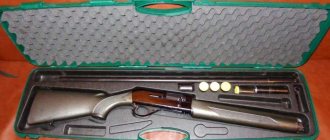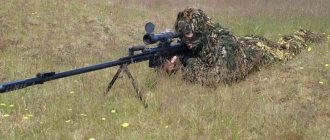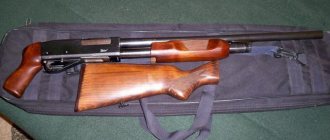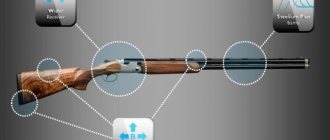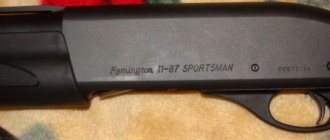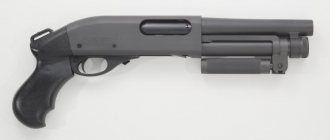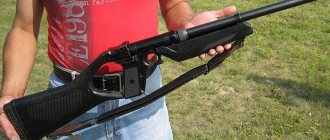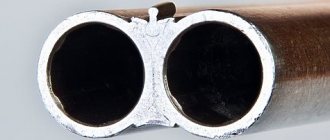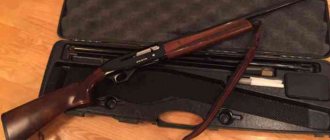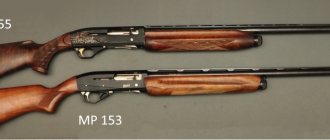MP-153 Baikal is a 12-gauge smoothbore semi-automatic shotgun, created by the Izhevsk Mechanical Plant in 1993 and produced in 1999-2011. Subsequently, the semi-automatic MP-155 was developed on its basis. Among hunters, this self-loading rifle is often called Murka. We can confidently consider the MP-153 hunting rifle one of the most popular and widespread domestic semi-automatic devices, designed on the basis of pump-action shotguns.
The MP-153 shotgun is considered a universal shotgun; it is excellent for hunting, self-defense, and sports shooting. The semi-automatic is reliable and can work well with different types of ammunition. The only thing that spoils the idyll is not the highest quality assembly; there are often cases when a new shotgun immediately causes problems with its poor-quality fitting of components.
At the moment, MP-153 Baikal shotguns are not produced, so they can be purchased exclusively on the secondary market for weapons for hunters.
With this approach, there is a high chance that the purchased semi-automatic machine will already be modified by the previous owner, but you should not fully hope for this. It happens that a low-quality gun with factory specifications passes through several hands, and each new owner, making sure that shooting from an MP-153 shotgun is far from ideal, tries to quickly get rid of the gun.
One of the key features of this model is its recognizable shape. Many shooters are familiar with the design of the tubular magazine located under the barrel. A similar solution is used by foreign manufacturers of hunting rifles, achieving the following advantages:
- good balance and well-chosen center of gravity;
- ease of use;
- compactness.
History of creation
The history of the MP-153 shotgun began in 1993, when the Izhevsk Mechanical Plant developed and launched its IZH-81 pump-action smoothbore shotgun. The creation of a pump-action shotgun was necessitated, since the Russian market for hunting weapons was filled with foreign models of pump-action shotguns, depriving Russian manufacturers of many potential customers.
The creation of IZH-81 could not have come at a better time. The reliable and trouble-free Russian pump-action shotgun was loved by many hunters, although many did not like its rough shape. Time passed, and after a few years, hunting rifles of a new system poured onto the Russian market - semi-automatic ones created on the basis of pump-action shotguns.
In 1997, development of a self-loading gun based on the IZH-81 began. Interestingly, these developments were of an initiative nature and were carried out by a group of enthusiasts. By 1998, it was possible to create two prototypes of a self-loading shotgun:
- The first was created by the design bureau of the Izhevsk Mechanical Plant.
- The second sample was submitted for testing by an employee of one of the Nizhny Novgorod private companies.
These specimens were tested in full, but their results were unsatisfactory. However, they interested the plant management so much that the developments were transferred to the category of planned and began to be carried out using all the capacities and resources of the design bureau. Already at the initial stage of development, it became clear that the IZH-81 receiver does not allow the use of cartridges longer than 70 mm.
The first factory model of a semi-automatic machine based on IZH-81 was called MP-151. The abbreviation “MR” had to be used instead of the abbreviation “IZH”, since it was planned to sell the new guns abroad, and it was very difficult to translate “IZH”.
Index "MR" from English. “Mechanical Plant” - Mechanical Plant and pronounced “EmPi”, not “EmEr” was produced at the Izhevsk Mechanical Plant (Baikal).
The first sample of the MP-151 was demonstrated at the Nuremberg international exhibition IWA'99. At the same exhibition, the American IZH dealer made it clear to management that the 12/70 mm semi-automatic would not be sold in the USA, since they needed 12/89 caliber guns. Shotguns of this caliber allow the use of a wide range of ammunition, ranging from lightweight 12/70 mm for clay pigeon shooting to powerful 12/89 mm cartridges.
Since the plant had already created a batch of MP-151 kits, 70 units of semi-automatic machines were assembled from them, which were sold in the Udmurt Republic.
The development of a new model, called MP-153, began in 1999. Already at the initial stages of development, it became clear that the IZH-81 design, which was used as the basis for the creation of the MP-153, needed deep reworking.
Main characteristics
On the Russian market, the MP-153 competed with weapons such as the classic Soviet “self-loading” MTs 21-12 and the Tula TOZ-87 gun, launched into production, as the name suggests, in 1987.
| MP-153 | MC 21-12 | TOZ-87 | |
| Caliber | 12/89 | 12/70 | 12/70 |
| Weight, kg | 3,4-3,5 | 3,4-3,7 | 3,1-3,2 |
| Length, mm | 1280 | 1285 | 1240 |
| Magazine capacity, cartridges | 4-8 | 4 | 4 |
The MTs 21-12 shotgun, produced since the 60s, practically replicates the Browning system in design using barrel recoil. This is a weapon that has been proven in production for a long time and is reliable in operation. TOZ-87, having a unique automatic design, is distinguished by accurate combat and lighter weight, but is “demanding” on the quality of ammunition, and its design is considered too complex. Hunters also complained about the build quality of the weapon.
But the main advantage of the Murka was not only the ability to use cartridges of any quality - but also of any power. Analogues were produced only with a chamber for a sleeve length of 70mm.
In 2011, the MP-153 semi-automatic shotgun was discontinued and replaced with the MP-155 model.
The new shotgun has become lighter, and its gas engine design has been optimized. Obviously, the changes are serious enough to consider the weapon not just an improved version, but a new model. The MP-153, of course, was not revolutionary in design and did not open a new era in the development of shotguns.
But the Murka showed many thousands of Russian shooters that a semi-automatic shotgun is not a “luxury”, but a completely affordable working tool. And the versatility of Izhevsk weapons made it possible to break the stereotype that the niche of self-loading rifles is bird hunting from ambush.
Similarities and differences between MP-153 and IZH-81
Although the IZH-81 and MP-153 shotguns are similar in appearance, they have much more differences than similarities. Similar parameters of the two models are:
- The principle of locking the barrels on the two models is absolutely similar;
- The MP-153 under-barrel magazine is exactly the same as on the IZH-81 model;
- A folding stock is available on modifications of both models. The ability of the butt to fold is good for weapons that are used for security or self-defense, but for hunting it is better to choose the classic modification.
A much longer list will be obtained if you start listing the differences between the MP-153 and IZH-81:
- The IZH-153 receiver is significantly different from the IZH-81 receiver. Its length has increased by 10 mm. At the same time, the width and height of the new receiver are smaller;
- The design of the rod that transmits movement from the piston to the bolt has been changed. As for the description of the new MP-153 thrust, it is a U-shaped part;
- The handguard on the MP-153 also took on a different shape. It became longer and thinner, which gave the MP-153 a certain elegance;
- The MP-153 shutter has become lighter, which has significantly simplified the operation of the automation. The MP-153 locking latch has also been lightened;
- The cartridge feeding mechanism has been changed. The new mechanism received one cartridge interceptor instead of two that were in the IZH-81 design;
- The design of the feed tray has also been changed.
In addition, many minor improvements were made to the design as a whole.
General information about the MP-153 shotgun
The MP-153 shotgun is a smooth-bore store-bought hunting rifle. Automation operates using the energy of powder gases. The gas piston is made of a ring type and moves along the outer surface of the magazine. The bolt engages the barrel after firing, resulting in reduced load on the receiver.
The MP-153 tubular magazine is located under the barrel. There is a special button that blocks the supply of ammunition into the chamber. This allows you to remove charges from the magazine or reload one cartridge at a time. Trigger USM. Safety is ensured by an automatic safety lock, which eliminates the possibility of firing when the bolt is unlocked. There is also a mechanical one - when activated, it blocks the trigger.
To make the forend on the MP-153 and the butt, either beech or walnut wood or impact-resistant plastic are used. A rubber shock absorber is installed on the butt, which reduces recoil during shooting. The mechanical sighting mechanism is made of a bar and a front sight.
Design Features
The gun is available in two calibers: 12/89 for the foreign market and 12/76 for the Russian market. Extended length chambers allow firing of all cartridges with a case length not exceeding the length of the chamber.
The MP-153 shotgun consists of the following main components and parts:
- a barrel with a gas chamber and a regulator for the rollback speed of moving parts;
- boxes with an under-barrel magazine and an interceptor;
- a movable gun system, which includes a piston, a rod assembly, a reloading handle and a bolt with a wedge;
- return spring;
- trigger mechanism (trigger mechanism);
- butt and forearm.
The design diagram of the semi-automatic MP-153 is a removal of powder gases with an automatic control of the impulse of the automation engine. The automation engine has an annular gas piston moving along the outer surface of the magazine tube.
The automatic gas regulator ensures reliable operation of the automation on various cartridges.
The bolt is longitudinally sliding, the barrel bore is locked by the lug lug of a swinging wedge located in the bolt and raised in the extreme forward position by a rod. The wedge's lug fits into a milled recess in the barrel coupling. The bolt moves on a frame with two steel rods, like in the Germanika gun.
Locking occurs using a single, recessed cam at the top of the bolt, which fits into a cutout in the extension of the barrel. The bolt moves on a carriage driven by two rods. Dual extractors pull the bolt casing out of the chamber.
The cartridge case is ejected by a fixed ejector with two teeth mounted on the left inner side of the receiver. The bolt is locked in the open position after the last cartridge is fired. To release the bolt, press the bolt release button on the front right of the receiver. The carriage stop lever is located on the right side of the receiver at the front end of the trigger housing.
When cocking the hammer, the bolt will not lock in the rearmost position unless this lever is pulled back.
The gas exhaust system operates on the principle of removing high-pressure gases through two holes at the bottom of the barrel. The gas pushes the piston and both rods back to operate the mechanisms and compress the return spring, which is concentrically placed on the tubular magazine. Excess gases are released through an automatically adjusted control system.
Parts exposed to powder gases (bore, chamber, piston, gas chamber) are chrome-plated. The valve and piston rings are made of stainless steel.
The gun barrels are made of carbon steel by hot forging, chrome-plated, and equipped with replaceable chokes adapted for steel shot. Each gun is equipped with interchangeable chokes in a set: a cylinder with pressure, a half choke and a full choke.
The MP-153 shotgun has a malleable aluminum alloy receiver and dual rods to prevent jamming.
The hammer mechanism is secured inside the receiver with two pins and can be easily removed for cleaning. There is a single “gold plated” trigger and a trigger locking safety located in the rear of the trigger guard.
The hammer-type trigger mechanism is made in the form of a detachable unit and is equipped with a safety system:
- from a shot when the bolt is not fully locked;
- non-automatic safety blocking the trigger.
The magazine is a tubular under-barrel magazine, with an improved system for cutting off cartridges during feeding. The magazine capacity can be increased using an extension cord. The recoil action reduces the rubber butt pad.
MAKSIMOV.SU
Just 10 years ago, “tulkas” and “izhaks”, with vertical or horizontal trunks, most often hung on the shoulders of hunters encountered in the forest.
The once more prestigious self-loading MTs21-12 was much less common.
Its time has passed - hunters are increasingly purchasing an Izhevsk gas-operated semi-automatic, which has become one of the “people's” guns and is known to everyone as the MP-153. Self-loading shotgun MP-153 on the hunt
On hands
hunters have a lot of “Bekas”, MTs21-12, TOZ-87, conversion “Saeg” and “Vepra”, and other self-loading weapons, including Turkish consumer goods and higher quality, but disproportionately expensive European weapons, which are advertised to us as “elite”.
MP-153
is a rather controversial weapon, having (as usual) both devoted supporters and fierce opponents. Nevertheless, “Murka” confidently leads in sales and prevalence. Let’s try to take an objective look at this gun, which at one time became a striking novelty on our (and not only) hunting market.
self-loading shotguns
in various designs
History of the development of MP-153
we will deliberately skip - we have already written about this a hundred times. We focus on practical details: choosing a gun and operating features.
Design
Information
from the manufacturer: MP-153 is the only domestic model of a self-loading shotgun, which is designed for the 12/89 cartridge and functions reliably with the entire range of 12-gauge cartridges - from 12/70 to 12/89 in any combinations, without additional adjustments and switching. A version with a 76 mm chamber is also available.
MP-153 self-loading shotgun
Constructive diagram of MP-153
— removal of powder gases with an automatic controller of the automation engine impulse. The coupling of the bolt directly to the barrel ensures the strength and durability of the locking, as well as unloading the receiver at the moment of firing.
Receiver
made of aluminum alloy. Parts exposed to powder gases (barrel bore, chamber, piston, gas chamber, outer surface of the magazine tube) are chrome-plated. The valve and piston rings are made of stainless steel.
MP-153 self-loading shotgun bolt with bolt shank, bolt handle
The trigger-type trigger mechanism is made in the form of a detachable unit,
equipped with a protection system: against firing when the bolt is not completely locked
and a non-automatic fuse,
which blocks the trigger
The MP-153 tubular under-barrel magazine, with an improved system for cutting off cartridges during feeding.
Capacity can be increased by extension
MP-153
produced in the following modifications: MP-153S - a service modification of the gun, intended for private security companies. With interchangeable choke tubes for firing lead and steel shot. Without an aiming bar with a rear sight and front sight.
With various options for the butt and forearm: made of walnut or beech, with a rubber shock absorber;
made of plastic, with a rubber shock absorber; with folding stock. Now the plant has launched the production of the Praktika sports model. The MP-153 shotgun
is available with barrels of various lengths - from 610 to 750 mm; with a 750 mm barrel, the length of the gun is no more than 1280 mm, weight - no more than 3.5 kg, depending on the material of the stock.
Application of MP-153
MP-153 is a completely universal gun
, although not a double-barreled shotgun, of course. If it also came with a short bullet barrel, like Molotov’s Bekas-Auto, it would be great. With the “paradox” of Tula production and various Shashkov bullets, “Murka” shows excellent results. A heavy, 47-gram bullet sent from the MP-153 through a 140-mm “paradox” is much more effective than a rifle bullet at distances of up to 100 m.
self-loading shotgun
, lower part of the bolt
About bird hunting
and so everything is clear - semi-automatic machines are considered preferable here to double-barreled guns. In addition, the factory workers sensed the situation in time and launched the production of the MP-153 in a version for practical shooting.
Of course,
This gun, with the appropriate body kit, is also suitable for law enforcement agencies - reliable smooth-bore self-loading guns in the city are preferable to army machine guns.
MP-153 self-loading shotgun removable bolt handle
"Murka"
compact for transportation, undemanding to care, although, as befits a gun with a gas-operated automatic circuit, it requires a significant amount of time for complete cleaning.
MP-153 self-loading shotgun
Gun “sores”
and their elimination
MP-153
a reliable gun that has a long service life: for people involved in practical shooting, the operating time of the Murok often exceeds 20-30 thousand shots. Few of my friends complained about any problems with this gun - they took it out of the box and hunted successfully and a lot, without thinking about high matters like fine-tuning the gun. So think about it - either they were lucky, or the problem of the MP-153 not being of the best quality is somewhat far-fetched?
Nevertheless,
and there are spots on the Sun, so a set of good needle files and a couple of sheets of car “skin”, with an attachment in the form of arms growing from the right place, can come in handy.
MP-153 self-loading shotgun
To reduce
If you are likely to purchase a defective gun, you need to pay close attention to inspecting the gun while still in the store. Remember - there is no need to be shy: demand that the sellers remove all the guns in the warehouse, they receive a salary for this inconvenience, and the gun, like the wife, must be chosen carefully. So as not to regret it later for many years.
The most important thing is the trunk.
Remove it from the gun, wipe it dry (it’s better to carefully bring a cleaning rod and rags with you; hunting stores usually have trouble with this). Of course, the barrel must be smooth, without variations in thickness, with a straight aiming rib and without pronounced “waviness” of the outer surface. Pay attention to the alignment of the choke tubes with the barrel - this is one of the most important factors in accurate combat.
MP-153 self-loading shotgun muzzle part of the barrel
If the barrel is good
– the rest is not so scary. Pull the shutter, smoothly, listening to the sensations on your finger, squeeze the trigger. The length of the trigger should not exceed 3-4 mm, otherwise when hunting for quite a long time until you get used to it, you will be late with the shot.
At home,
To prevent the problem of a “split butt”, you must immediately remove the butt and use a narrow chisel to deepen the groove in the front end, into which, during recoil, the bolt frame shank fits. The overhang of the shank is approximately 6 mm, so you need to cut the groove to a depth of 7-8 mm. Otherwise, the butt may simply split with the first shots.
MP-153 self-loading shotgun that same tree overhanging the metal receiver
At the same time
you can trim the wood hanging over the receiver (especially in the upper part of the end of the butt), adjust the geometry of the pistol grip of the butt to suit you, lengthen or shorten the butt, change the pitch by processing the front end of the butt or using self-made spacers, etc. It is better to wipe the affected areas with linseed oil for artists.
And - forward,
for "run-in". You need to shoot at cans a lot, preferably with magnum cartridges, let all the automatic parts of the gun get used to it. There is no point in scolding the manufacturer too much - after all, new cars are also tested. As a rule, after “breaking in”, there are no problems when shooting with any cartridges. It is better not to adjust the gas outlet yourself. And so, as a rule, everything works great.
If desired
with the metal of the gun, even before the first shooting, you can carry out all the necessary and unnecessary operations: remove sharp edges, burrs in the receiver and other parts, grind and polish the bolt, frame, gas outlet parts, make a radial notch on the front of the tray for feeding cartridges - When filling the magazine, it will not “bite” your finger.
Do not forget
– all work is carried out without fanaticism, according to the principle: “think a hundred times and change your mind once.” It’s better to look for diamond files, but only old, Soviet ones, with a very fine coating.
Skin
- from a car shop, numbers - from 400 to 1500, finer is not required - “hammered” sandpaper 1500 “finishes” the surface no worse than new 2000. It is very desirable to use the sandpaper on a flat, hard carrier - either wrapped around a file or glued to a wooden block. And - ALL movements with the skin are carried out strictly in one direction, no circular or oblique movements. In the case of the MP-153, this is not so critical, but it is worth keeping in mind.
MP-153 self-loading shotgun barrel branding
Special attention
requires trigger gun. In a good way, if you missed labor lessons in a Soviet school or do not have the habit of reading a gun’s passport, it is better not to get into the trigger yourself - you can ruin the mechanism or get a problem in the form of unauthorized shots.
Approximately
a quarter of the MP-153 has an excessively long trigger stroke. However, many hunters do not notice this. But, if the long travel of the gun trigger does not suit you, then the most correct solution to this problem is to replace the sear pusher with a new part, but with an elongated shoulder. The smoothness of the trigger is achieved by grinding and polishing the sear tooth and cocking trigger - a troublesome task, but worth the time and effort.
Main requirements
for successful modification of the gun mechanism - the ability and desire to “listen” to the metal, understand the causes of problems, analyze, and put your hands to the right place.
This work is small, thoughtful, but interesting and capable of bringing satisfaction from the work done. You will have a good opportunity to evaluate your work on the hunt. MP-153 self-loading shotgun receiving tray
Finally
No need
to make mountains out of molehills. Many hunters simply do not notice the sometimes significant shortcomings in the assembly and finishing of the gun. They simply hunt, using the MP-153 as a tool, ruthlessly exploiting it for its intended purpose. If necessary, pick up a file or screwdriver.
Any gun
- it’s just a piece of iron, only more or less carefully processed. If you don’t like the very thought of possibly tinkering with a gun, you’re reading this article in vain - for you, Europeans are churning out “correct” self-loading guns on CNC machines. Although, of course, evil sometimes takes its toll on our gunsmiths - raise prices, but pay more attention to assembly and finishing! You are not making an AK “for war”, but a HUNTING weapon...
Two MP-153 shotguns,
in wood and in plastic
Price difference
between MP-153 and foreign analogues reaches several times, and, as often happens, the final result does not depend in any way on the price and manufacturer. Moreover, the relatively inexpensive “foreign” product from across the Black Sea usually outperforms our “Murka” only in advertising brochures.
Yes, and “real Europeans”
Sometimes such incidents are revealed that one gets the impression that not only expired medicines and low-quality products, but also any industrial defects have been “leaked” into Russia for a long time.
The advertisements do not show cross-cut cracked stocks, untreated edges in the mechanics, torn receivers and burst bolts. Sighting bar for the MP-153 shotgun
Don't forget
that much of what is presented to us under the “elite” sauce is just Western consumer goods. However, over the 25 years of “perestroika”, many of our thinking compatriots were able to understand this and draw adequate conclusions.
if you
You were lucky or managed to pick up a more or less high-quality assembled MP-153 in the store - it will serve you for many years. Minor defects are relatively easy to fix. “Murka” is truly an omnivorous and reliable gun, with a huge margin of safety.
A kind of shooting UAZ.
The MP-153 works in conditions where eminent “foreigners” refuse - in the conditions of the tundra and taiga this has been tested in practice, more than once. The ability to use different choke constrictions makes the gun relatively versatile.
Fight at the gun
excellent in all respects, sufficient for any hunting. The balance can be “leveled” with a lead insert in the butt. The “plastic” version turns the MP-153 into an excellent tool for hunting waterfowl and, in general, for use in adverse conditions.
Quite
reasonable price brings “Murka” into the niche of budget weapons, accessible to almost every hunter in our country who wants to hunt with self-loading.
Shooting from the MP-153 gun
The article was published
in the magazine "Hunting"
Operating principle of MP-153
The domestic shotgun MP-153 is very easy to use. The removal of powder gases is carried out through slots with a diameter of 3 mm. There are two of them in total, and they are located on the breech of the barrel.
Charging the MP-153 does not present any difficulties. The shooter has two options:
- load cartridges into the magazine;
- insert one cartridge into the chamber.
In the first case, ammunition is stowed through the lower window in the store. You must first lower the elevator lever inside the receiver. In the second case, the arrow should:
- put the gun on safety;
- retract the bolt frame and place it on the bolt stop;
- put the cartridge on the elevator;
- press the button located above the bunker window.
At the moment of firing, the powder gases push the piston, which in turn activates the bolt frame. Moving back, she ejects the spent cartridge case, compresses the return spring and cocks the trigger mechanism. At this moment, the elevator lifts the cartridge from the magazine and it is sent into the chamber by the return spring. The bolt cylinder lever rises, after which it engages with the cutout in the shank. The gun is ready to fire again.
Specifications
Let's give the technical specifications of the MP-153 Baikal shotgun, they look like this:
- Action type: self-loading gun, operating on the principle of removing powder gases from the barrel.
- Caliber: 12/76, 12/89.
- Barrel: chrome-plated barrel, with ventilated rib.
- Barrel length: 610, 660, 710, 750 mm.
- Bore diameter: 18.4 mm.
- Magazine: tubular under-barrel.
- Magazine capacity: 4+1 rounds for a gun with a 76 mm chamber, and 3+1 rounds for a gun with an 89 mm chamber.
- Stock: Birch, beech, walnut, plastic.
- Gun length: 1280 mm for a gun with a 750 mm barrel.
- Weight of the gun: 3.4-3.5 kg depending on the material of the butt.
The MP-153's warranty life is 3,000 rounds; in practice, the gun begins to act up and require repairs when about 4,000-5,000 rounds are fired; compared to domestic semi-automatic guns, it is quite reliable.
MURKA. MP-153 - the people's gun of Russia
Just 10 years ago, “tulkas” and “izhaks”, with vertical or horizontal trunks, most often hung on the shoulders of hunters encountered in the forest. The once more prestigious self-loading MTs21-12 was much less common. Its time has passed - hunters are increasingly purchasing an Izhevsk gas-operated semi-automatic, which has become one of the “people's” guns and is known to everyone as the MP-153.
Of course, hunters have a lot of “Bekas”, MTs21-12, TOZ-87, conversion “Saeg” and “Vepr”, and other self-loading weapons, including Turkish consumer goods and higher quality, but disproportionately expensive European weapons, which are given to us by advertising as “ elite."
The MP-153 is a rather controversial weapon, having (as usual) both loyal supporters and fierce opponents. Nevertheless, “Murka” confidently leads in sales and prevalence. Let’s try to take an objective look at this gun, which at one time became a striking novelty on our (and not only) hunting market.
We will deliberately skip the history of the development of the MP-153 - we have already written about it a hundred times. We focus on practical details: choosing a gun and operating features.
Design
Information from the manufacturer: MP-153 is the only domestic model of a self-loading shotgun, which is designed for the 12/89 cartridge and functions reliably with the entire range of 12-gauge cartridges - from 12/70 to 12/89 in any combinations, without additional adjustments and switching . A version with a 76 mm chamber is also available.
The design diagram of the MP-153 is a removal of powder gases with an automatic control of the impulse of the automation engine. The coupling of the bolt directly to the barrel ensures the strength and durability of the locking, as well as unloading the receiver at the moment of firing. The receiver is made of aluminum alloy. Parts exposed to powder gases (barrel bore, chamber, piston, gas chamber, outer surface of the magazine tube) are chrome-plated. The valve and piston rings are made of stainless steel.
The hammer-type trigger mechanism is made in the form of a detachable unit, equipped with a protection system: against firing when the bolt is not completely locked and a non-automatic safety blocking the trigger.
The magazine is tubular under-barrel, with an improved system for cutting off cartridges during feeding. Capacity can be increased with an extension cord.
The MP-153 is produced in the following modifications: MP-153S is a service modification of the gun intended for private security companies. With interchangeable choke tubes for firing lead and steel shot. Without an aiming bar with a rear sight and front sight. With various options for the butt and forearm: made of walnut or beech, with a rubber shock absorber; made of plastic, with a rubber shock absorber; with folding stock. Now the plant has launched the production of the Praktika sports model.
The gun is produced with barrels of various lengths - from 610 to 750 mm, with a 750 mm barrel the length of the gun is no more than 1280 mm, weight - no more than 3.5 kg, depending on the material of the stock.
Application
The MP-153 is a completely universal gun, although not a double-barreled shotgun, of course. If it also came with a short bullet barrel, like Molotov’s Bekas-Auto, it would be great. With the “paradox” of Tula production and various Shashkov bullets, “Murka” shows excellent results. A heavy, 47-gram bullet sent from the MP-153 through a 140-mm “paradox” is much more effective than a rifle bullet at distances of up to 100 m.
Everything is clear about bird hunting - semi-automatic guns are considered preferable here to double-barreled guns. In addition, the factory workers sensed the situation in time and launched the production of the MP-153 in a version for practical shooting. Of course, this gun, with the appropriate body kit, will also be suitable for law enforcement agencies - reliable smooth-bore self-loading guns in the “city” are preferable to army machine guns.
“Murka” is compact for transportation, undemanding to care, although, as befits a gun with a gas-operated automatic circuit, it requires a significant amount of time for complete cleaning.
Gun “sores” and their elimination
The MP-153 is a reliable gun with a long service life: for people involved in practical shooting, the operating time of the Murok often exceeds 20-30 thousand shots. Few of my friends complained about any problems with this gun - they took it out of the box and hunted successfully and a lot, without thinking about high matters like fine-tuning the gun. So think about it - either they were lucky, or the problem of the MP-153 not being of the best quality is somewhat far-fetched?
However, there are spots on the Sun, too, so a set of good needle files and a couple of sheets of car “skin”, with an attachment in the form of hands growing from the right place, can come in handy.
In any case, to minimize the likelihood of purchasing a defective gun, you need to pay close attention to inspecting the gun in the store. Remember - there is no need to be shy: demand that the sellers remove all the guns in the warehouse, they receive a salary for this inconvenience, and the gun, like the wife, must be chosen carefully. So as not to regret it later for many years.
The most important thing is the trunk. Remove it from the gun, wipe it dry (it’s better to carefully bring a cleaning rod and rags with you; hunting stores usually have trouble with this). Of course, the barrel must be smooth, without variations in thickness, with a straight aiming rib and without pronounced “waviness” of the outer surface. Pay attention to the alignment of the choke tubes with the barrel - this is one of the most important factors in accurate combat.
If the barrel is good, the rest is not so scary. Pull the shutter, smoothly, listening to the sensations on your finger, squeeze the trigger. The length of the trigger should not exceed 3-4 mm, otherwise when hunting for quite a long time until you get used to it, you will be late with the shot.
At home, to prevent the problem of a “split butt”, you must immediately remove the butt and use a narrow chisel to deepen the groove in the front end, into which, during recoil, the bolt frame shank fits. The overhang of the shank is approximately 6 mm, so you need to cut the groove to a depth of 7-8 mm. Otherwise, the butt may simply split with the first shots.
At the same time, you can trim the tree hanging over the receiver (especially in the upper part of the end of the butt), adjust the geometry of the pistol grip of the butt to suit you, lengthen or shorten the butt, change the pitch by processing the front end of the butt or using self-made spacers, etc. It is better to wipe the affected areas with linseed oil for artists.
And - forward, to the “break-in”. You need to shoot at cans a lot, preferably with magnum cartridges, let all the automatic parts of the gun get used to it. There is no point in scolding the manufacturer too much - after all, new cars are also tested. As a rule, after “breaking in”, there are no problems when shooting with any cartridges. It is better not to adjust the gas outlet yourself. And so, as a rule, everything works great.
If desired, with the metal of the gun, even before the first shooting, you can carry out all the necessary and unnecessary operations: remove sharp edges, burrs in the receiver and other parts, grind and polish the bolt, frame, gas outlet parts, make a radial notch on the front of the tray for feeding cartridges - when filling the magazine, your finger will not “bite”. Don’t forget - all work is carried out without fanaticism, according to the principle: “think a hundred times and change your mind once.” It’s better to look for diamond files, but only old, Soviet ones, with a very fine coating. Sandpaper - from a car shop, numbers - from 400 to 1500, finer is not required - “hammered” sandpaper 1500 “finishes” the surface no worse than new 2000. It is very desirable to use the sandpaper on a flat hard carrier - either wrapped around a needle file or glued to a wooden block . And - ALL movements with the skin are carried out strictly in one direction, no circular or oblique movements. In the case of the MP-153, this is not so critical, but it is worth keeping in mind.
The trigger mechanism of the gun requires special attention. In a good way, if you missed labor lessons in a Soviet school or do not have the habit of reading a gun’s passport, it is better not to get into the trigger yourself - you can ruin the mechanism or get a problem in the form of unauthorized shots. About a quarter of the MP-153 has an excessively long trigger stroke. However, many hunters do not notice this. But, if the long travel of the gun trigger does not suit you, then the most correct solution to this problem is to replace the sear pusher with a new part, but with an elongated shoulder. The smoothness of the trigger is achieved by grinding and polishing the sear tooth and cocking trigger - a troublesome task, but worth the time and effort.
The main requirements for successful modification of the gun mechanism are the ability and desire to “listen” to the metal, understand the causes of problems, analyze, and put your hands to the right place. This work is small, thoughtful, but interesting and capable of bringing satisfaction from the work done. You will have a good opportunity to evaluate your work on the hunt.
Finally
There is no need to make mountains out of molehills. Many hunters simply do not notice the sometimes significant shortcomings in the assembly and finishing of the gun. They simply hunt, using the MP-153 as a tool, ruthlessly exploiting it for its intended purpose. If necessary, pick up a file or screwdriver.
Any gun is just a piece of iron, only more or less carefully processed. If you don’t like the very thought of possibly tinkering with a gun, you’re reading this article in vain - for you, Europeans are churning out “correct” self-loading guns on CNC machines. Although, of course, evil sometimes takes its toll on our gunsmiths - raise prices, but pay more attention to assembly and finishing! You are not making an AK “for war”, but a HUNTING weapon...
The difference in price between the MP-153 and foreign analogues reaches several times, and, as often happens, the final result does not depend in any way on the price and manufacturer. Moreover, the relatively inexpensive “foreign” product from across the Black Sea usually outperforms our “Murka” only in advertising brochures. Yes, and “real Europeans” sometimes produce such incidents that one gets the impression that not only expired medicines and low-quality products, but also any industrial defects have been “drained” into Russia for a long time. The advertisements do not show cross-cut cracked stocks, untreated edges in the mechanics, torn receivers and burst bolts. We should not forget that much of what is presented to us under the “elite” sauce is just Western consumer goods. However, over the 25 years of “perestroika”, many of our thinking compatriots were able to understand this and draw adequate conclusions.
If you are lucky or manage to pick up a more or less high-quality assembled MP-153 in a store, it will serve you for many years. Minor defects are relatively easy to fix. “Murka” is truly an omnivorous and reliable gun, with a huge margin of safety. A kind of shooting UAZ. The MP-153 works in conditions where eminent “foreigners” refuse - in the conditions of the tundra and taiga this has been tested in practice, more than once. The ability to use different choke constrictions makes the gun relatively versatile. The gun's combat is more than acceptable. The balance can be “leveled” with a lead insert in the butt. The “plastic” version turns the MP-153 into an excellent tool for hunting waterfowl and, in general, for use in adverse conditions.
And the quite reasonable price brings the Murka into the niche of a budget weapon, accessible to almost every hunter in our country who wants to hunt with self-loading.
Yuri Maksimov
Advantages and disadvantages
The strengths of the MP-153 Baikal self-loading shotgun include:
- The main advantage of the gun is its inexpensive price; in terms of price-quality ratio, the gun has no equal, neither among domestic guns, nor even more so foreign ones.
- The gun is omnivorous, the gun fires cartridges with almost any weight of shot and gunpowder, ranging from 24 to 66 grams. You can also use cartridges with an 89 mm sleeve. The adjustable gas piston, if necessary, can be adjusted to the appropriate type of ammunition. Gun jams are extremely rare and are most often associated with either low-quality cartridges or insufficient care of the gun.
- The gun's rate of fire is its great advantage over classic double-barreled shotguns, especially when hunting waterfowl.
- The reliability of the gun, the gun continues to work in any weather conditions, regardless of water, dirt, or low temperature. In terms of reliability, it can be compared with a Kalashnikov assault rifle. The gun forgives the owner even careless use.
- The gun has quite comfortable recoil, thanks to its heavy weight and its gas-operated operating principle.
- The MP-153 shotgun can be easily tuned and repaired; any spare parts and tuning elements can be easily found on sale (stocks, magazine extensions, barrel extensions, etc.). The shotgun can be repaired in any gunsmith workshop or even a gun store.
- The warranty life of the MP-153 shotgun is 3000 shots. As practice shows, a gun can withstand 4000-5000 rounds, only after that problems and the need for repairs appear. Although, of course, a lot depends on the owner of the gun and how he operated and maintained it. In any case, the MP-153 is the most reliable of the domestic semi-automatic shotguns.
The disadvantages are:
- The weight of the gun is too high, the gun is not very suitable for running hunting, the optimal hunting for the MP-153 gun is goose hunting and duck hunting on flights.
- Poor balance of the gun, the balance of the gun is very forward, especially with a fully loaded magazine. It is quite problematic to shoot from a gun offhand, at short range.
- The quality of the gun is inconsistent; when purchasing a gun, you need to carefully inspect and select the gun, preferably with an experienced person.
- The receiver of the gun is made of aluminum alloy and does not have a rail for mounting an optical sight. Many owners install red dot sights on their guns; to do this, they drill holes in the receiver and tap them. When installing a massive sight, recoil may break the thread when firing.
- The gun does not have a smooth trigger release.
- The only way to unload a gun is by passing cartridges through the chamber, which takes a long time and creates a lot of noise.
- Poor small safety button, located in an inconvenient place.
- The bolt handle is held extremely weakly; many hunters lose it during the hunt. Many even immediately buy themselves a spare one, so that when hunting far from home they don’t end up with a non-functional gun.
The first attempt to develop a gas-operated shotgun semiautomatic device at the Izhevsk Mechanical Plant was made by designer N. Galunov in the early 60s. The sample received the index IZH-21, and at the same time the “pump” being developed was IZH-20.
Unfortunately, no orders were received and development was stopped.
With the beginning of the conversion in the late 80s, a “pump-action” shotgun was developed for special forces, which received the index IZH-80.
It had dual power: to quickly change the type of ammunition, the under-barrel magazine could be turned off, a box magazine was inserted from below, and cartridges were supplied from it.
After disconnecting the box magazine, shooting could continue with the supply of cartridges from the under-barrel magazine.
Due to the lack of orders, it was decided to develop a simplified hunting version under the symbol IZH-81, and it was produced for almost ten years with barrels of various lengths (700, 600 and 560 mm), a box made of high-strength aluminum alloy, a permanent or folding butt, an under-barrel or box magazine, in regular and magnum versions, and even with a pistol grip. Quite a lot of IZH-81s were exported - Algerian orders alone amounted to about 100 thousand guns!
Comparison of samples of shotgun semiautomatic devices.
| Semi-automatic model | MP-153 | TOZ-87 | MC-21-12R | Beretta Urika AL391 | Browning Gold | Bekas-12M Auto |
| Gun caliber | 12/89 | 12/70 | 12/70 | 12/76 | 12/76 | 12/70 |
| Gun weight, kg | 3.72l | 3.06 | 3.62 | 3.20 | 3.62 | 3.45 |
| Barrel weight, kg | 1.16 | 1.41 | 1.18 | 1.04 | 1.26 | 1.07 |
| Presence of nozzles on the measured sample | + | — | — | + | + | + |
| Barrel length, mm | 660 | 715 | 749 | 760 | 760 | 680 |
| Overall length, mm | 1205 | 1240 | 1265 | 1275 | 1300 | 1207 |
| Maximum length of disassembled gun, mm | 860 | 890 | 830 | 890 | 890 | 875 |
| Piston stroke, mm | 22.1 | — | 93.5 | 14.2 | 100 | |
| Barrel diameter, mm: 75 mm from the treasury at the muzzle | 26.0 22.4 | 25.2 21.2 | 27.0 21.0 | 26.9 22.2 | 27.5 22.6 | 27.2 23.4 |
With the production of the pump-action gun well established, the idea of turning it into a semi-automatic machine was naturally in the air. In 1998, such a task was set before the young designer Konstantin Evseev, and very quickly he designed a new gun, which received the MP-151 index.
When it was almost assembled, a similar sample was brought from Nizhny Novgorod by employee Chigrinsky.
However, long-term testing and the release of a trial batch of MP-151 shotguns showed that designing a semi-automatic requires a different approach. It became clear that the seemingly obvious engine design with manual adjustment of the amount of exhaust gases complicates the operation of the gun and has a bad effect on reliability. One way or another, the MP-151 gun was considered a failure.
When designing a new semi-automatic machine, mistakes, our own and those of others, were taken into account, successful technical solutions already known in the world were widely used, and K.E. Evseev created a new gun called MP-153. A special imprint on the design was left by the fact that at the same time the task was set to optimize the semi-automatic for the American market, so the gas outlet was initially designed for the “supermagnum” cartridge.
The decision turned out to be correct; a heavy semi-automatic machine chambered for a reinforced cartridge is best suited for hunting waterfowl, being a modern “goose gun”. It is the ability to use powerful cartridges along with conventional ones that, in my opinion, is one of the main factors in the success of the MP-153.
The gun turned out to be quite successful, although later, based on the results of its operation, significant modifications had to be made. A great contribution to the mastery of production of the MP-153 and the MP-133 “pump”, which was maximally unified with it, was made by design engineer A.I. Kalugin.
Of course, there are certain controversial elements in the gun; sometimes it seems that it should not work normally at all. But it works. It works without problems with almost all cartridges, I shot it myself, loading 12/70, 12/76, 12/89 mixed. It doesn’t always reload, perhaps, only from a sports cartridge with 24 g of shot, and even from the “Taiga” you come across “weak” batches.
One way or another, it turned out that the people needed just such a gun. It quickly entered the list of “One Hundred Best Products of Russia”, many Russian arms dealers recognized it as a sales leader, and two hunting magazines “Guns & Ammo” and “Sports Afield” named it the gun of 2001 in the USA.
Of course, Browning Gold and Beretta Urica are better finished, but they also cost three to five times more.
Gas unit of the MP-153 shotgun:
1
- nut
2
- spring
3
- sealing ring
4
- thrust bushing
5
- compensator piston
6
- washer
7
- spring washer
8
- rod
9
- sealing piston
10
- piston bushing
11
- spacer bushing
And there are problems with them too, but I haven’t heard of spare parts for them yet. Some things cannot be properly lubricated - you need special tools, but if you don’t clean and lubricate them, the shutter does not move forward (a real-life incident). But this is all true, by the way.
Remembering Kozma Prutkov, I will say: “And there are spots on the Sun,” having stipulated in advance that this is not an attempt to anti-advertise the MP-153. To one degree or another, something similar can be said about every model of any company.
I will not touch on the features inherent in all heavy semi-automatic weapons, since there are many cases when a gun is initially inferior to a double-barreled shotgun: this is hunting in the forest, when an extra hundred grams is a burden, you often need to quietly change the cartridges in the barrels, it is inconvenient to carry a long gun in a case on a train or on a bus, and you don’t have to shoot often. This is also a fast, offhand shooting, almost in a round shooting range.
Conversely, a semi-automatic machine wins when hunting in open spaces, on a flight or from a boat, when you don’t need to carry a gun and a large supply of cartridges, one shot number is used, a large magazine capacity is important, the situation is closer to shooting in a trench. The store is generally much more “gluttonous” and more exciting than the break.
Recently, quite a lot of different references to the MP-153 have appeared in the weapons press. Some praise, some scold: “Everyone has their own shortcomings.” American buyers, for example, consider the absence of a plastic stock and forearm to be one of the major disadvantages of the MP-153 as a gun intended for hunting waterfowl, and Izhmekhzavod has already begun their production. For our hunters this still sounds crazy, although personally I would be glad to have a replacement set made of plastic for my IZH-58MA.
Some surprise was caused by a letter from Tataria published in MasterRuzhye © 68 regarding the MP-153. Everything seems to be correct, but it is very unclear: praise is not praise, and criticism is not criticism. In my opinion, the anti-advertising did not work. I can say one thing: if you don’t like a serial gun, buy an MP-153 gun from Strela or Browning and estimate the price of hand-finishing.
Unfortunately, the rough ventilation grooves of the sighting bar are not the most unpleasant features of the gun. (By the way, MP-153 is bought very well in Tatarstan).
Let me give you a few examples:
1.
I consider the most unpleasant cases of breakages of the receivers of guns of the first releases during shooting due to improper assembly of the bolt, despite separate (it must be said, inconspicuous) instructions in the passport, which in an era of universal literacy almost no one reads.
If the wedge is installed incorrectly in the bolt (locking with a backward bevel), the latter does not lock in the forward position; when fired, it goes back at high speed and breaks the receiver.
To avoid this, the passport included instructions to check the movement of the striker after assembly - if assembly is incorrect, the striker will not return back. In 2001, to eliminate the possibility of incorrect assembly, the design of the shutter was modified, and now error is impossible.
2. In principle, the gun has the ability to adjust the gas outlet.
On guns intended for export to America, there is a corresponding marking on the body of the gas chamber, and the kit includes an adjustment key combined with a key for the choke tubes.
But it’s better not to do this unless absolutely necessary - the gun already works quite reliably with a very wide range of charge power. The only exception is the case of jamming of a piston incorrectly selected on the assembly
(in principle, the parts are completely interchangeable, but defects cannot be completely eliminated), which is checked as follows. On a vertically positioned (barrel down) gun, the piston with the ring, retracted to a distance of no more than 60 mm from the rear end of the rack and released, must, under the influence of its own weight, reach the lowest position. The check must be carried out without moving parts (bolt frame and bolt with piston), pressing the base surface of the chamber nut against the magazine tube in different directions. If there is rubbing of the piston, it is necessary to ensure that the piston enters the chamber freely by slightly turning the nut in one direction or another.
3. The gun is available with chamber lengths of 76 and 89 mm.
Barrel length can be 660 mm (usually in the USA with an 89 mm chamber) and 710 mm.
750 mm long barrels are produced in small batches. I consider a 66-centimeter barrel to be the most convenient, especially if the factory produces an additional nozzle 5-6 cm long with a strong 1.2 mm choke and pre-barrel expansion. The outer diameter of the nozzle is 20.8 mm, which will allow you to screw two nozzles into the IZH-27. The IZH-27 barrel has a diameter in the middle part of 20.4 mm, but the attachment, unlike the barrel, can be made of alloy steel and hardened.
Unfortunately, the two-start inch thread makes it very difficult to make such a nozzle yourself.
I consider the long chamber of 89 mm to be a positive side.
This has virtually no effect on combat with a short cartridge, but in the future it will allow the use of cartridges with steel shot - well, we’re not idiots constantly poisoning our own land with lead.
Mechanism MP-153:
1
- bolt
2
- wedge
3
- firing pin
4
5
- sear
6 -
sear
pusher
7
button
9 10
- holder
11
-
delay
12
- interceptor
13
- bolt handle
14 -
magazine cup
I hope we won’t have to wait long for a ban on using lead shot when hunting on water bodies. By the way, the lethality of steel shot at reasonable distances is no worse than lead shot and depends more on the shooter, since it requires other skills.
4.
Some people complain about the edge of the steel (there are simply no brass) cups of the cartridge case sticking into the sharp edge of the chamber flange.
Indeed , the mechanical plant stubbornly does not pay attention to the dulling of sharp edges.
But this is not difficult to eliminate, the main thing is not to overdo it. And when reloading, cartridge cases must be calibrated, even all-metal ones (this was recommended by S.A. Buturlin), but the ring must be selected that is not too strict.
Modern imported cartridges are very weak and are poorly calibrated, but the edge of the cup, which bends outward when fired, must be bent inward, otherwise sticking will occur. By the way, this is especially noticeable not on the MP-153, but on the lower barrel of the IZH-27. Very rare, but also found on the MP-153, is the sharp edge of the case flange sticking into the junction of the magazine tube and the box jumper; a chamfer has to be applied to the edge of the latter.
It must be admitted that Tula semi-automatic devices are more prone to this, especially when using a metal sleeve with a flange that is sharper than that of a plastic sleeve cup or a calibrated imported sleeve in which the flange is flattened.
5.
The MP-153 reloading handle has a fastening design similar to that of the Beretta Urika and is very easy to remove from the bolt.
On guns of the first releases there were cases of its loss. Later this deficiency was eliminated, and such cases stopped.
6.
Owners of not only the MP-153, but many guns in general, complain about the rusting coating of steel parts.
In general, modern alkaline oxidation coating wears off easily but has greater corrosion resistance than the old "rusty varnish", although the latter is second only to chrome plating in terms of abrasion resistance. Therefore, to protect the barrels from rust, it is necessary to use a thicker mineral oil than conventional RJ containing kerosene.
It is not without reason that almost all the trunk coating processes described by S.A. Buturlin in the book “Shotguns and Shooting from It,” 1937 edition, end by lubricating the coating with hot drying oil. At least once a season, especially for those who hunt near water, to impart moisture resistance, it is necessary to lubricate wooden parts with drying oil (of course, if they are not varnished). After several hours of exposure, the drying oil should be wiped with a rag.
7.
Like the bore and other parts that work with powder gases, the magazine tube must be regularly cleaned and lubricated - despite the chrome coating, powder gases can burn through it quite quickly.
By the way, on the gas pistons of many guns of the first releases, there are through holes from milling in the corners of the grooves for placing thrust. This was allowed in the design documentation and is not a defect, although it does make cleaning somewhat more difficult after firing.
8. Like many other automatic systems, some samples of the MP-153 may malfunction when firing without pressing the butt to the shoulder.
In principle, you can put a pistol grip from the MP-133 “pump” on a gun, but after that you need to check its functionality.
Before removing and installing the MP-153 stock, in order to avoid its breakage, it is necessary to remove the base of the trigger mechanism by knocking out the pins securing it. On IZH-81, a drift for knocking them out was placed on the magazine nut. It is not provided in the MP-153 kit.
9.
The magazine design allows the use of extension cords.
The conventional extension nut allows for more capacity per round due to a longer spring, and is typically factory installed on 89mm chambered shotguns shipped to the United States. For ease of handling of a disassembled gun (without a barrel), a special plastic plug is placed under the magazine nut, which must be removed before hunting to increase the magazine capacity, although this will complicate disassembly and reassembly (the spring is longer than the magazine).
A design for an extension for two cartridges has also been developed, which does not require the installation of an extended spring, but it is not yet in production.
Of course, increasing capacity is not necessary for all hunters. It remains to add that a semi-automatic machine requires a careful study of the material part. When shooting, you need to use better quality cartridges and be more attentive to the gun, since it is more difficult to determine the power of cartridges when shooting from it than when shooting.
In general, gun store sellers in Izhevsk do not praise the MP-153.
Anyone who understands praises the TOZ-87: the ingenious design of the automatics by N. Babanin, especially the locking of the bolt from untimely locking (I write this without a drop of humor), the lightest semi-automatic shotgun, and the barrel with the box is tightly connected, there are long nozzles “paradox” and “ supergoose." The MTs-21-12 is praised: a long-established and classic design with a long barrel stroke, soft recoil and an adjustable recoil system; Both attachments and spare parts are available for sale. The Bekas-Auto is also a good car and looks good, and even a child can shoot with pleasure from the Saiga-410. The Saiga-12 magazine can be easily removed and replaced if necessary. In general, “Saiga-12”, “Magnum” with a long thick barrel, a screwed-on long muzzle attachment, a huge 8-round box magazine, and an easily removable (replaceable with a handle) semi-pistol birch butt leaves a strong impression.
And the MP-153 is made rather roughly, not like the Beretta or Browning: the sharp end of the butt sticks out above the frame, the pistol grip is a bit thick, sometimes the forend wobbles, there is no space for a red dot sight, the factory does not want an elongated attachment with a strong choke release, you have to make the removable rear sight and front sight for firing a bullet yourself, and you still have to look for spare parts.
Yes, sellers of the MP-153 do not praise it. But they know that “with all the wealth of choice, there is no other alternative”, that those guns that will be left over from export to America will immediately sell out. If only the plant could produce more of them.
Victor Valnev
Modifications
Over the 12 years of production of the MP-153 shotgun, it had a large number of modifications for different conditions of use:
- Hunting modifications - the largest number of design options: can be with a chamber of 76 or 89 mm, the butt can be made of wood or plastic, the barrel length can be: 610, 660, 710, 750 mm, choke constrictions can be either replaceable or permanent .
- MP-153S is a service model, produced in 2005-2006 and intended for use in private security companies. The MP-153S has a shortened barrel with a length of 510 mm, a constant muzzle constriction, like a cylinder. Chambered for 12/76 cartridge. The buttstock of this model is folding, the frame has a shoulder rest, the buttstock is removable. The model has a pistol grip made of black plastic. A special feature of this model is the ability to fire with the stock removed.
- Remington Spartan 453 - the MP-153 shotgun under this brand was produced at the Izhevsk Mechanical Plant in 2006-2008 for export to the USA.
- MP-153 for practical shooting is a modification of the MP-153 shotgun, manufactured in accordance with IPSC rules and intended for sports use. It has a magazine for 9 rounds of 12/70, the receiver has a Picatinny rail for mounting a sight, large safety and interceptor buttons, the butt and fore-end are made of impact-resistant plastic.
- 18.5 KS-P modification of the MP-153, which has been in service with the Ministry of Internal Affairs of the Russian Federation since 2006. Part of SSK-18.5 - Special Rifle Complex of 18.5 mm caliber. The carbine has a 6-round magazine, a folding stock, a plastic fore-end and a pistol grip. The receiver has a Picatinny rail designed for mounting various types of sights. The carbine allows you to fire both different types of bullets (lead, armor-piercing, rubber) and special grenades (flash-noise, tear gas). Not intended for free sale.
It is possible to change the design of the butt and replace it with a pistol grip. Brackets for mounting rails for optics on the receiver are available for sale.
Tuning MP-153 Baikal
The MP-153 shotgun provides great tuning opportunities. There are a large number of spare parts and tuning elements on sale, like for no other gun. The owner can replace the wooden butt with an impact-resistant plastic one and vice versa. You can replace the stock with a pistol grip.
Often, gun owners equip them with a collimator sight; for this purpose, a special rail is installed on the receiver. It is recommended to purchase additional choke constrictions for tuning the MP-153 shotgun. You can also install a magazine extension to increase its capacity.
By tuning the gun, the owner can adjust it to his individual requirements.
Disassembly
The process of disassembling the MP-153 self-loading shotgun is as follows:
- Unload your weapon.
- Unscrew the nut on the magazine, remove the plug, spring and cartridge feeder.
- Remove the forend.
- Pull the bolt frame back and, by sliding the gas engine tube along the magazine tube, remove the barrel from mating with the receiver.
- While holding the bolt cylinder retracted, remove the manual cocking handle.
- By pulling the piston of the gas engine, remove the bolt frame assembly with rod from the receiver.
- Remove the rod, separate the frame and the bolt cylinder.
- Remove the return spring and damper clutch from the magazine.
- Knock out two pins and remove the trigger from the receiver.
At the moment, the MP-153 Baikal shotgun has been discontinued and is sold only secondhand. The price for a shotgun ranges from 15 to 25 thousand rubles.
As for reviews from real owners of the MP-153, the situation here is ambiguous. Those hunters who have modified their semi-automatic machine speak extremely positively about it, and on the contrary, those who do not want to bother with modifications often complain about bad Izhevsk assemblers. If the future owner is not ready to bother with modifications, it is better for him to refuse to purchase this semi-automatic machine.
As analogues, we can recommend more expensive and high-quality foreign models of guns of a similar class or a new model from the Izhevsk plant - MP-155. The new model has become much lighter and is also available in 20 gauge.
At first glance, the MP-153 semi-automatic shotgun makes a favorable impression. The gun has a good grip and has a sharp action. If you initially eliminate factory defects and monitor the state of operation of the automation, the gun will please its owner for many years. The problem is that not every hunter is ready to take such care of his weapon.
